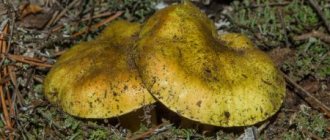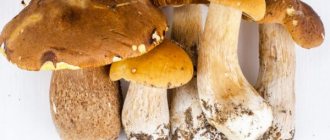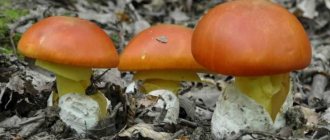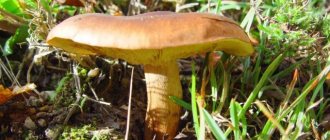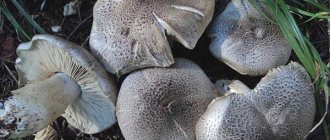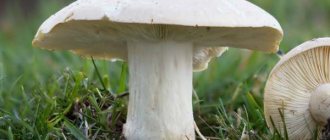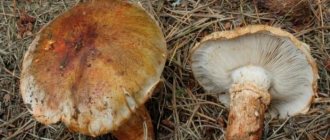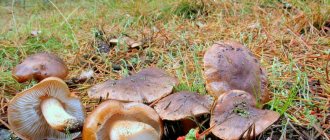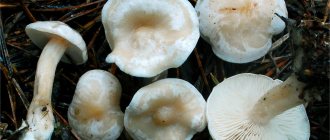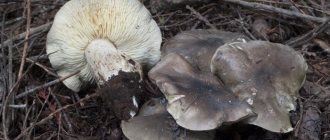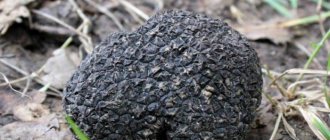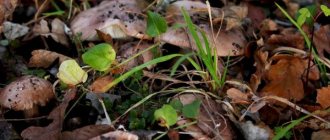Description of edible mushroom
Lepista or violet row has the Latin name Lepista irina, belongs to the genus Lepista of the row family. Some scientists believe that this species should be classified as a genus of talkers.
The cap grows up to 13 cm in diameter, in a young fetus it is convex, with age it opens up and becomes almost flat, the edge is often wavy and tucked.
The surface is smooth, whitish, and as it grows it acquires a yellowish tint, sometimes with a pink tone or brown spots.
The lower part of the cap is called the hymenophore. In the violet row it has a lamellar appearance and is white. Later, the plates acquire pinkish-brown tones. The spores are creamy, slightly pink.
The pulp has a soft texture, the color can vary from white to brown, with pinkish tints. It has no taste, sometimes the taste of young corn is detected. The aroma is bright, floral. The color does not change when cut.
The stem is medium-sized, reaches 8 cm in height, usually no more than 2.5 cm in thickness. It grows in the center of the cap, is smooth, and can thicken in the lower part.
It can be fibrous or finely scaly. The color is light, and as it grows it acquires pinkish or brown inclusions.
In 1959, the American botanist and mycologist Howard Elson Bigelow first spoke about this mushroom and described its features.
This scientist paid the most attention to the family of rank-leaved family, in addition, he studied quite a lot of boletaceae.
Similar species
- The talker is smoky.
This mushroom can be distinguished by the lamellar layer attached to the stalk and descending along it. Another sign is a much sharper, “perfume” smell of the talker pulp.
- The row is truncated.
Very similar in appearance, taste and aroma. However, their taste and commercial value are equal, so there is no risk of confusing it with the violet row. The only difference visible to the naked eye is the elongated leg, compared to the rows.
- Leaf-loving talker.
It has a strong floury or herbal smell of the pulp and a cap that lacks the pink hue characteristic of the violet row.
1-Smoky talker. 2-Row truncated. 3-The leaf-loving talker.
Growing at home and in the country
You can grow violet row at home or in your summer cottage; this is no more difficult to do than getting a harvest of champignons. But there are some differences, especially regarding environmental conditions.
First of all, you should pay close attention to the air temperature; it should be at the level of 10–15 0C. It is for this reason that May is considered the best month for planting, but this procedure can also be postponed to autumn.
When planting indoors, mushrooms should be provided with sufficient light and access to fresh air. Soil moisture also needs to be monitored very carefully:
- drying out soil will destroy young fruiting bodies at the initial stage of development;
- too wet - it will negatively affect the mycelium, it will grow so that fruits will not be able to emerge from it.
Fruiting lasts up to 4 months; mushrooms are harvested when the caps become flat, and after harvesting, the top layer is sprinkled with earth. It is easier to grow rows in the garden than indoors, and during cold weather, beds with mushrooms should be covered with burlap and fallen leaves.
For planting row mycelium, a mixture of dry straw and manure is suitable; you can take either bird, horse or cow manure. To create nutritious soil, you need to mix 12 kg of straw with 8 kg of manure and leave it until the ripening stage for 22 to 26 days.
The prepared mixture is mixed with mycelium, which can be purchased in specialized stores, everything is moistened and covered.
After 20 days, the mycelium will grow over the surface of the soil, and after another 20 days the first fruiting bodies will appear, then the cover can be removed. Mushrooms grow best at a temperature of 20 0C. At first the harvest appears in waves, but then becomes continuous.
Children's playground: how to keep children busy all the time
But the most important “natural disaster” - children - is often completely forgotten when arranging a site. But you don’t want your kids, nephews and just small guests of friends to break some expensive lamp out of boredom, start a serious fire in the barbecue, or hopelessly clog the filters in the pond?
But it’s true that sometimes a holiday outside the city can be painfully similar to a comedy. Although it would be more correct to call such a weekend “nine crazy adults and two children who really have nothing to do.” Just set aside the farthest corner of the area in front of the bathhouse for a children's playground - and direct this uncontrollable chaos there.
So, where do kids usually like to spend time? The first is a tree house. You can put together this miracle of architecture with your own hands from ordinary inexpensive boards. You can even draw the design yourself, just take care of the safety and stability of the structure itself. And then paint the wood with durable facade paint - and the house is ready!
The second successful solution is a garden swing. Just make them wide enough so that several children can sit at once and attach one extra bar on top so that later this swing cannot describe a circle (for safety reasons).
All this is really necessary, because the child will not sit in the steam room for a long time, and the rest of the hours he will have to occupy himself with something. Let your relaxation in the bathhouse be without smartphones, tablets and e-books!
False doubles
Danger awaits lovers of quiet hunting after frost, when mushrooms lose their scent and practically do not emit it. But it is not difficult to distinguish a poisonous species; just carefully examine the find, and if in doubt, do not collect the fruiting bodies and leave them in the forest.
| Name | Taste and smell | Hat and leg | Danger |
| Lepista violet | Floral aroma, sweetish or light corn taste | Whitish, matte cap, leg widened towards the base, white. May have pinkish tints throughout the fruit body. | Edible |
| Smoky talker (white form) | Fruity, perfumey aroma | The color of the mushroom is yellowish, off-white, the stalk is club-shaped, grayish. | Edible |
| White row | There is an unpleasant odor reminiscent of radish, the taste is acrid, burning | A grayish-white mushroom, in the center the cap is yellowish, often brown, covered with ocher spots, the stem matches the tone of the cap. When broken, the flesh changes color. | Poisonous |
| Grayish talker | The taste is astringent, with an aftertaste, the aroma is pleasant, spicy, very strong | The cap is covered with a white waxy coating, and itself is flesh-colored; the leg is cylindrical, flattened from white and often becomes a dirty ocher color. | Poisonous |
| Whitish talker | The smell is mealy, the taste is practically absent or inexpressive | Powdery white or grayish white cap, buffy in older ones, the stem is cylindrical, tapering towards the bottom. | Poisonous |
Taxonomy
Kinds
- Lepista caespitosa (Bres.) Singer, 1951
- Lepista densifolia (J. Favre) Singer & Clémençon, 1972
- Lepista diemii Singer, 1954
- Lepista fibrosissima Singer, 1954
- Lepista flaccida (Sowerby) Pat., 1887
- Lepista glaucocana (Bres.) Singer, 1951 - Lepista gray-blue, or lilac-gray
- Lepista irina (Fr.) HE Bigelow, 1959 - Violet row, or Violet lepista, or Perfume row
- Lepista luscina (Fr.) Singer, 1951
- Lepista multiformis (Romell) Gulden, 1983
- Lepista nuda (Bull.) Cooke, 1871 - Violet row, or Lepista naked
- Lepista ovispora (J. E. Lange) Gulden, 1983
- Lepista panaeolus (Fr.) P. Karst., 1879
- Lepista personata (Fr.) Cooke, 1871
- Lepista pseudoectypa (M. Lange) Gulden, 1983
- Lepista rickenii Singer, 1948
- Lepista sordida (Schumach.) Singer, 1951 - Dirty row, or Dirty Lepista
- Lepista subaequalis (Britzelm.) Singer, 1951
Taste assessment
The mushroom is considered edible, has high taste, and is equated to the purple row. Lepista can cause mild, non-life-threatening stomach upsets, and therefore should be consumed unless contraindicated.
Attention! Children under 7 years of age, pregnant and lactating women should avoid using row. If you have diseases that are in the acute stage (especially the gastrointestinal tract), you should refrain from eating mushrooms.
Primary processing and cooking recipes
Mushrooms must be processed as soon as possible after collection. The rows should not be kept in water for a long time; they will become tasteless.
It is better to rinse them under running water. It is necessary to clean the fruits from forest debris, sort them, remove rotten and wormy ones.
Then pre-boiling is required. Water with added salt to taste is brought to a boil, the lepistas are lowered into it and boiled for 30 minutes.
Now the mushrooms are ready for further processing. Violet rows can be frozen, fried, salted and pickled. They are wonderful in a mushroom mixture, stewed with sour cream.
In order to pickle, for 2 kg of fruit you will need:
- salt – 4 tbsp. l.;
- laurel – 6 pcs.;
- dill umbrellas – 3 pcs.;
- allspice peas – 6 pcs.;
- garlic – 6 cloves.
Salting process:
- Pre-boiled mushrooms are laid out in layers in a prepared container, alternating with salt.
- As the layers form, place the spices evenly over the entire area; they can be laid out on each row or every other row.
- Sprinkle everything on top with salt, cover with gauze and press down with a weight, place the container in a dark, cool place.
- After 3 weeks, you can try the mushrooms, and also put them in jars and put them in the refrigerator on the bottom shelf.
It is necessary to pay attention to the formation of brine, which should appear no later than three days after salting, and increase the load as necessary.
If you need to freeze mushrooms for the winter, then after boiling they should be cooled and distributed into portioned containers, which should be placed in the freezer. You can take it out as needed; defrosting before cooking is not required.
To marinate violet row, for 2 kg of mushrooms you will need:
- salt – 2 tbsp. l.;
- water – 2 l;
- sugar – 1 tbsp. l.;
- peppercorns – 5 pcs.;
- laurel – 3 pcs.;
- cloves – 3 pcs.;
- garlic – 3 cloves;
- horseradish and currant leaves 2 pcs.;
- vinegar - 4 tbsp. l.
Cooking process:
- Bring water with salt and sugar to a boil.
- Place pepper, bay, cloves, crushed garlic, horseradish and currant leaves there. Boil for a minute.
- Add vinegar, then fruiting bodies.
- Cook for 10-15 minutes.
- Place the rows in jars and fill them with marinade so that the fruits are completely covered with liquid. Place in the refrigerator.
The preparation can be eaten immediately and served.
Distribution and use of violet row
Distribution: European countries, as well as North America. In Russia, violet row can be found in the Primorsky and Khabarovsk Territories, as well as in the Amur Region. It grows in groups or rows, choosing mixed, coniferous and deciduous forests. Occurs in autumn (late August-October), forming “witch rings”.
Peak mushroom harvesting occurs in September-early October.
If weather conditions permit, the fruiting body can be detected even in November and December. In this case, you need to pay special attention to open places: the edge of the forest, forest edges and meadows. It grows simultaneously with purple row (Lepista nuda) - an edible mushroom. Often both species are found in the same places.
Application: There are many processing options for violet mushrooms. Most often they are pickled, salted and fried. Sometimes housewives freeze the fruiting body for the winter. The mushroom requires preliminary boiling for 20 minutes.
The given photo and description of the violet row mushroom will help you thoroughly prepare for the mushroom hunt and not miss a single edible mushroom.
However, never forget the main rule when collecting fruiting bodies: “ if you’re not sure, don’t take it!” "
Artificial pond and patio: learning from valuable experience
Americans have very well organized patios: from the house itself there is a fairly large terrace that ends with a swimming pool or a small artificial pond. This is convenient: after the steam room, your bare feet do not touch dirt and dust, and you can immediately dive into cool water without worrying that sand from your feet will clog the filters again. Also, the dirt no longer rushes back into the bathhouse. For a real Russian steam room - a wonderful extension! And it's called "patio".
But it is not necessary to adhere to a strict design concept here: you can place the pond wherever your heart desires, and instead of a long terrace, just build a path to it. You can even install a fountain or an artificial stream, everything is extremely simple:
Bluefoot (Lepista saeva)
Taxonomy:
- Division: Basidiomycota (Basidiomycetes)
- Subdivision: Agaricomycotina (Agaricomycetes)
- Class: Agaricomycetes (Agaricomycetes)
- Subclass: Agaricomycetidae (Agaricomycetes)
- Order: Agaricales (Agaric or Lamellar)
- Family: Tricholomataceae
- Genus: Lepista (Lepista)
- Species: Lepista saeva (Blueleg)
- Other names for the mushroom:
- Lilac-legged rower
- Lilac-legged row
- Two-color row
Bluefoot;
- Submanager;
- Blue root>;
- Lepista personata.
Blueleg (Lepista saeva, Lepista personata) is a mushroom from the genus Ryadovok, belonging to the family Ryadovkov (Tricholomov). This type of mushroom is very resistant to cold weather, and its growing season can continue even when the outside temperature drops to -4ºC or -6ºC.
Beneficial features
So, is the purple row a mushroom edible or not? Let us emphasize once again that the species belongs to the category of conditionally edible, which implies mandatory heat treatment. Eating raw bluelegs causes poisoning. When properly prepared, fruiting bodies are not only edible and tasty, but also extremely healthy.
Chemical composition
Cyanosis contains in large quantities:
- ascorbic, nicotinic, pantothenic acids;
- choline;
- betaine;
- potassium, magnesium, sodium, calcium phosphorus.
Also includes:
- tocopherol;
- riboflavin;
- thiamine;
- folic acid;
- iron, copper, manganese, zinc.
Benefit
Bluefoot is a low-calorie product. Mostly (90%) it consists of water. 100 g contains only 20 kcal, 3 g of protein and carbohydrates, 1 g of dietary fiber and 0.8 g of ash.
Consumption of mushroom dishes:
- promotes cleansing of toxins;
- helps cope with fatigue;
- promotes speedy recovery after surgery;
- improves blood circulation;
- stabilizes sugar levels and blood pressure;
- helps fight inflammation and fungal diseases;
- strengthens the immune system, increasing resistance to viral diseases.
